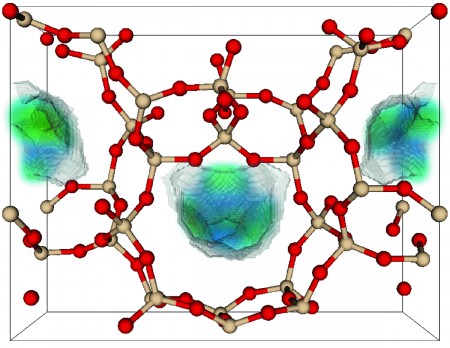May
31
Catching CO2 More Cheaply
May 31, 2012 | 2 Comments
The team determined that new materials could help electricity producers slash as much as 30 percent of the “parasitic energy” costs associated with removing carbon dioxide from power plant emissions.
The research paper was published online this week in the journal Nature Materials.
In the new study, researchers found that commonly used industrial minerals called zeolites could significantly improve the energy efficiency of “carbon capture” technology.
Study co-author Michael Deem, Rice’s John W. Cox Professor of Bioengineering and professor of physics and astronomy discusses the results, “It looks like we can beat the current state-of-the-art technology by about 30%, and not just with one or two zeolites. Our analysis showed that dozens of zeolites are more efficient than the amine absorbents currently used for CO2 capture.”
Deem pointed out the new study is the first to compare the “parasitic energy” costs for a whole class of carbon-capture materials. The study found dozens of zeolites that could remove CO2 from flue gas for a lower energy cost than amines could.
Zeolites are common minerals made mostly of silicon and oxygen. About 40 occur naturally, and there are about 160 man-made types. All zeolites are highly porous – like microscopic Swiss cheese and the pore sizes and shapes vary depending upon how the silicon and oxygen atoms are arranged.
The pores act like tiny reaction vessels that capture, sort and spur chemical reactions of various kinds, depending upon the size and shape of the pores. The chemical industry uses zeolites to refine gasoline and to make laundry detergent and many other products.
Beginning in 2007, the team used computers to calculate millions of atomic formulations for zeolites, and continued to add information to the resulting catalog, which now contains about 4 million zeolite structures.
With 4 million zeolites in hand the zeolite database was examined with a new computer model designed to identify candidates for CO2 capture. Berend Smit, UC Berkeley’s Chancellor’s Professor in the departments of chemical and biomolecular engineering and of chemistry and a faculty senior scientist at LBNL and his team worked with study co-author Abhoyjit Bhown, a technical executive at EPRI, to establish the best criteria for a good carbon capture material. Focusing on the energy costs of capture, release and compression, they created a formula to calculate the energy consumption for any materials in the zeolite database.
It could have been a massive undertaking. Running the painstaking calculations to compare the CO2-capture abilities of each zeolite would have taken approximately five years with standard computer central processing units. But Smit and his colleagues at UC-Berkeley and LBNL created a new way to run the calculations on graphics processing units, or GPUs – the processors used in PC graphics cards. Deem said the GPU technique cut the compute time to about one month, which made the project feasible.
Smit said, “Our database of carbon capture materials is going to be coupled to a model of a full plant design, so if we have a new material, we can immediately see whether this material makes sense for an actual design.”
The target is coal and natural gas fired power plants that account for about half of the carbon dioxide that civilization adds to the atmosphere each year. As it stands now current technology for capturing that CO2 and storing it underground can consume up to as much as one-third of the steam the plant could otherwise use to make electricity.
So far, harvesting CO2 is a dreadfully expensive proposition. Even the new materials that the team isolated would leave a cost at close to 20%. CO2 is going to need a high value to justify its capture.
The cost is driven by the process demands. Today commercial power plants do not capture CO2 on a large scale, but the amine-based technology has been tested at pilot plants. The pilots funnel the flue gasses through a bath of the ammonia-like chemicals known as amines. The amines are then boiled to release the captured CO2, and additional energy is required to compress the CO2 so it can be stored or pumped underground.
Those are high-energy process costs with the current technology. That one-third of the steam that could be used to generate electricity siphoned off to boil the amines and liquefy the CO2 would drop the generation capacity in the U.S. at 40% to perhaps 28%. Coming up with 12% more electric power would be quite a problem and a huge investment and operating cost.
The team’s zeolites are a big help. But somewhere there needs to be another 50% cut in operating costs.
CO2 harvesting is much closer and still so very far away.
Comments
2 Comments so far



All very nice, but when you have concentrated the goodie it is time to make a product. So, under what conditions and at what cost does the zeolite release the CO2 ?
yes i agreed that zeolite could significantly improve the energy efficiency of “carbon capture” technology. Thank you for the sharing. I am doing a topic on this too.